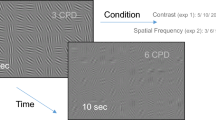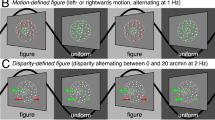Abstract
THE motion aftereffect is a much studied and well documented phenomenon. After viewing a moving visual pattern for a period of time, the same pattern appears to drift in the opposite direction when it is stopped1. Psychophysical experiments involving inter-ocular transfer2,3, dichoptic stimulation4, and motion aftereffects contingent upon other visual parameters such as colour5,6, orientation5 and texture7, imply that the motion aftereffect is generated at the level of the visual cortex. It has been hypothesized that cortical neurons specialized for the detection of motion along a particular direction become 'fatigued' during the adaptation period so that the resting equilibrium subsequently shifts in the opposite direction to that of the adapting stimulus, giving rise to the sensation of the aftereffect8–13. I have found that if observers are engaged in a separate discrimination task superimposed on a moving textured background, the subsequent motion aftereffect to the background is considerably reduced. It seems that motion aftereffects are susceptible to attentional mechanisms.
This is a preview of subscription content, access via your institution
Access options
Subscribe to this journal
Receive 51 print issues and online access
$199.00 per year
only $3.90 per issue
Buy this article
- Purchase on Springer Link
- Instant access to full article PDF
Prices may be subject to local taxes which are calculated during checkout
Similar content being viewed by others
References
1. Wohlgemuth, A. Brit J. Psycho!. 1, 1–117 (1911). 2. Barlow, H. B. & Brindley, G. S. Nature 200, 1347 (1963). 3. Faveau, O. E. Vision Res. 16, 181–186 (1976). 4. Anstis, S. M. & Moulden, B. P. Q. J. exp. Psychol. 22, 222–229 (1970). 5. Mayhew, J. E. W. & Anstis, S. M. Percept. Psychophys. 12, 77–85 (1972). 6. Potts, M. J. & Harris, J. P. Vision Res. 15, 1225–1230 (1975). 7. Walker, J. T. Psychonom. Sci. 28, 333–335 (1972). 8. Sutherland, N. S. Q. J. exp. Psychol. 13, 222–228 (1961). 9. Sekuler, R. W. & Ganz, L. Science 139, 419–420 (1963). 10. Barlow, H. B. & Hill, R. M. Nature 200, 1345–1347 (1963). 11. Vautin, R. G. & Berkley, M. A. J. Neurophysiol. 40, 1051–1065 (1977). 12. Petersen, S. E., Baker, J. F. & Allman, J. M. Brain Res. 346, 146–150 (1985). 13. Hammond, P., Mouat, G. S. V. & Smith, A. T. Expl Brain Res. 72,1–20 (1988). 14. Grindley, C G. & Townsend, V. Q. J. exp. Psychol. 20, 11–19 (1968). 15. Posner, M. I. Q. J. exp. Psychol. 32, 3–25 (1980). 16. Remington, R. & Pierce, L Percept. Psychophys. 35, 393–399 (1984). 17. Moran, J. & Desimone, R. Science 229, 782–784 (1985). 18. Sato, T. J. Neurophysiol. 60, 344–364 (1988). 19. Mountcastle, V. B., Andersen, R. A. & Motter, B. C. J. Neurosci. 1, 1218–1235 (1981). 20. Wenderoth, P., Bray, R. & Johnstone, S. Perception 17, 81–91 (1988). 21. Harris, L. R., Morgan, M. J. & Still, A. W. Nature 293, 139–141 (1981). 22. Judge, S. J., Richmond, B. J. & Chu, F. C. Vision Res. 20, 535–538 (1980). 23. Collewijn, H., van der Mark, F. & Jansen, T. C. Vision Res. 15, 447–450 (1975).
Author information
Authors and Affiliations
Rights and permissions
About this article
Cite this article
Chaudhuri, A. Modulation of the motion aftereffect by selective attention. Nature 344, 60–62 (1990). https://doi.org/10.1038/344060a0
Received:
Accepted:
Issue Date:
DOI: https://doi.org/10.1038/344060a0
This article is cited by
-
Lack of orientation specific adaptation to vertically oriented Glass patterns in human visual cortex: an fMRI adaptation investigation
Scientific Reports (2023)
-
Dichoptic vision in the absence of attention: neither fusion nor rivalry
Scientific Reports (2019)
-
Congruent audio-visual stimulation during adaptation modulates the subsequently experienced visual motion aftereffect
Scientific Reports (2019)
-
Concentrative Meditation Influences Visual Awareness: a Study with Color Afterimages
Mindfulness (2017)
-
Habituation of visual adaptation
Scientific Reports (2016)
Comments
By submitting a comment you agree to abide by our Terms and Community Guidelines. If you find something abusive or that does not comply with our terms or guidelines please flag it as inappropriate.



